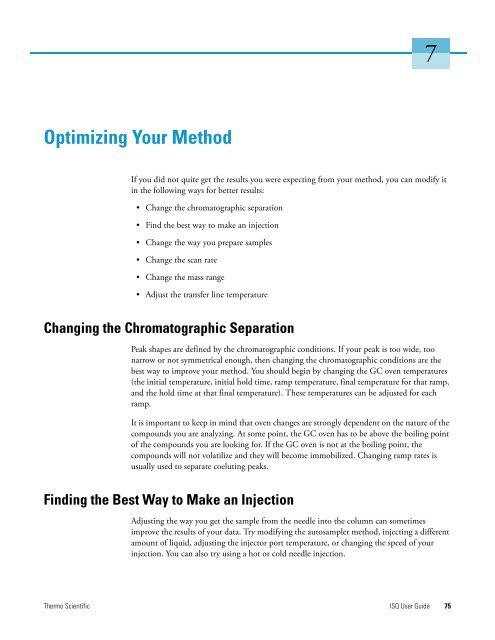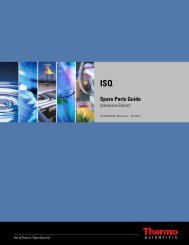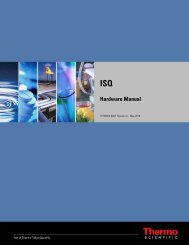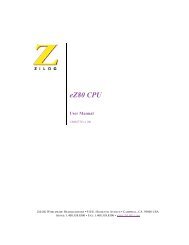ISQ User Guide - Write Frame of Mind
ISQ User Guide - Write Frame of Mind
ISQ User Guide - Write Frame of Mind
You also want an ePaper? Increase the reach of your titles
YUMPU automatically turns print PDFs into web optimized ePapers that Google loves.
Optimizing Your Method<br />
If you did not quite get the results you were expecting from your method, you can modify it<br />
in the following ways for better results:<br />
• Change the chromatographic separation<br />
• Find the best way to make an injection<br />
• Change the way you prepare samples<br />
• Change the scan rate<br />
• Change the mass range<br />
• Adjust the transfer line temperature<br />
Changing the Chromatographic Separation<br />
Peak shapes are defined by the chromatographic conditions. If your peak is too wide, too<br />
narrow or not symmetrical enough, then changing the chromatographic conditions are the<br />
best way to improve your method. You should begin by changing the GC oven temperatures<br />
(the initial temperature, initial hold time, ramp temperature, final temperature for that ramp,<br />
and the hold time at that final temperature). These temperatures can be adjusted for each<br />
ramp.<br />
It is important to keep in mind that oven changes are strongly dependent on the nature <strong>of</strong> the<br />
compounds you are analyzing. At some point, the GC oven has to be above the boiling point<br />
<strong>of</strong> the compounds you are looking for. If the GC oven is not at the boiling point, the<br />
compounds will not volatilize and they will become immobilized. Changing ramp rates is<br />
usually used to separate coeluting peaks.<br />
Finding the Best Way to Make an Injection<br />
Adjusting the way you get the sample from the needle into the column can sometimes<br />
improve the results <strong>of</strong> your data. Try modifying the autosampler method, injecting a different<br />
amount <strong>of</strong> liquid, adjusting the injector port temperature, or changing the speed <strong>of</strong> your<br />
injection. You can also try using a hot or cold needle injection.<br />
Thermo Scientific <strong>ISQ</strong> <strong>User</strong> <strong>Guide</strong> 75<br />
7






